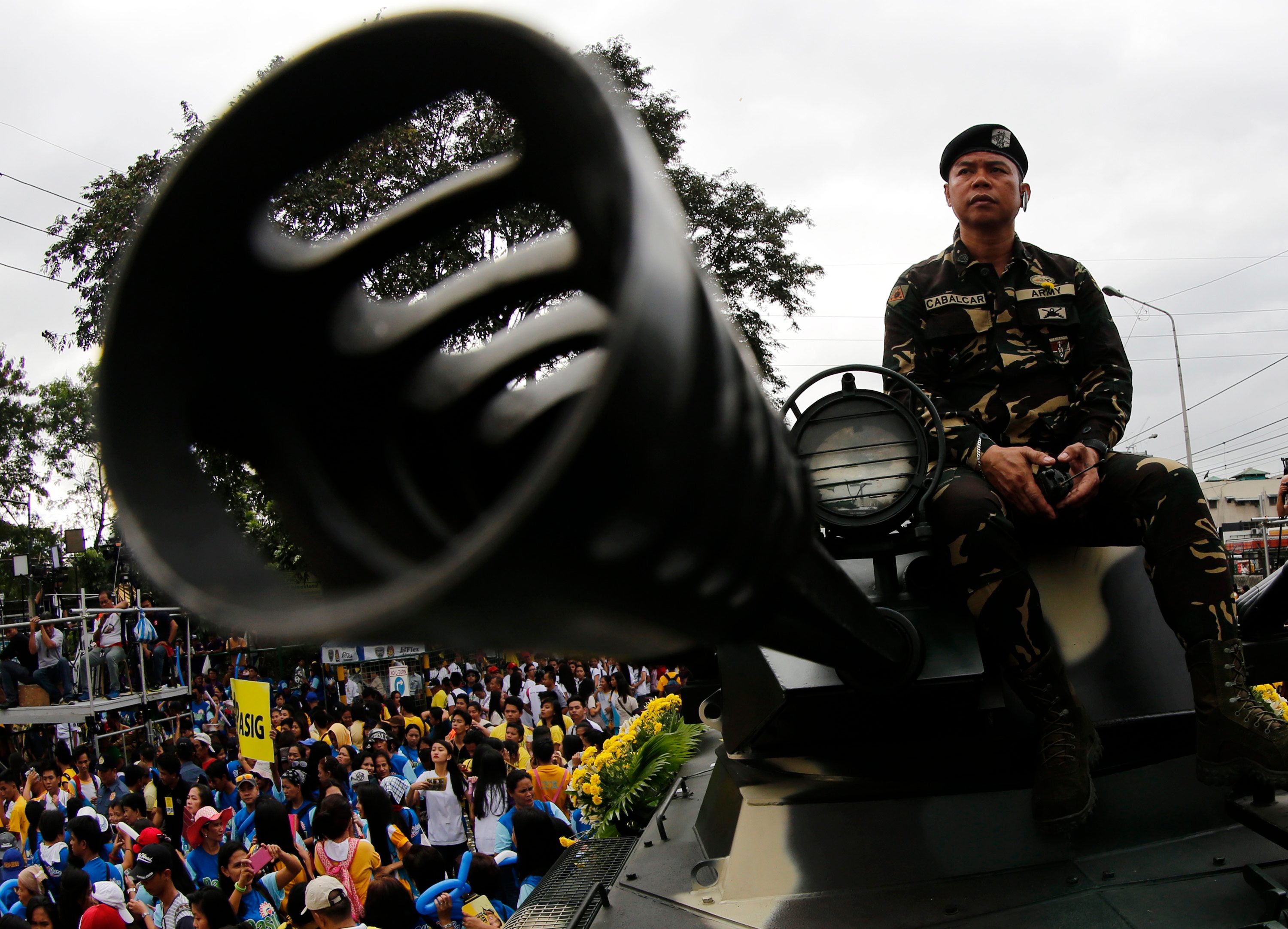SUMMARY
This is AI generated summarization, which may have errors. For context, always refer to the full article.

(This is the preface for Angela Stuart Santiago’s book EDSA: The Original People’s Power Revolution, which the author wrote in 2013.)
Writing of those days of February 1986, when so many of us brave but foolhardy souls believed we could stop General Artemio Tadiar and his grim Marines from advancing their tanks upon us, Angela Stuart Santiago captures the transformative impact of that experience:
Going to EDSA was like stepping into another world. Altered states. In the unified field of consciousness that was EDSA, the people found themselves rising above religious, political, and class differences, and willfully daring new ways of thinking and acting, relating and bonding, for the sake of the whole. EDSA was an unexpected threat, a taste, a glimpse, of a happier kind of existence. Life can be better, kinder, fairer. People can be selfless, caring, and cooperative. The people were feeling great, feeling affirmed by every other one’s presence for the first time experiencing and enjoying, a sense of connectedness with one’s fellow Pinoys [and Pinays], a sense of unity and harmony and wholeness, which spirit lifted and expanded and enlightened every self, rendered it strong and steadfast and brave and, as it turned out, powerful enough to “disarm” Marcos’s soldiers.
As I read these lines, I found myself transported back in time to Santolan Road, in the early morning of 24th February 1986, the second day of the stand-off between a bunch of failed coup plotters protected by a million people and the Philippine Marines sent in by the ailing dictator Ferdinand Marcos to eliminate them.
In that narrow street, a handful of us remained to man the barricades. The rest of that million had gone home to the comforts of their beds. We students stayed because our dormitory bunks were not that comfortable; besides, there was free food and drinks to be had!
Our shabby defensive perimeter had, by early morning, dwindled to about 20 people who drifted in and out of sleep as we sought to maintain our position. Suddenly, we awakened to the distinctive smell of tear gas. Through the morning haze, we began to make out a phalanx of marines with bayonets fixed on their armalites, slowly marching toward us. Their boots created this ominous crunch that echoed through the street, bouncing off the walls, telling us to prepare to meet our fate.
As they drew closer we found no mercy in their eyes. Some were grinning. Exhausted and on edge, the marines had had enough of this “people’s power.” Many had been flown straight from the jungles of southwestern Mindanao, made to march from Fort Bonifacio to the Meralco-White Plains district. They clearly wanted an end to this business, intending to break through our line and kill if necessary to clear the way for a larger force to bring down the failed coup plotters. Then they could get their much-deserved sleep.

Those of us from UP – veterans of street battles against the police and military in places like Mendiola Bridge, Avenida Rizal, and Quezon Boulevard – immediately sensed our disadvantage. Yet we knew we had to slow the marines’ advance long enough to allow runners to alert the rebels and disperse the crowd milling around the front of the camps, protecting both from a major assault by the Marcos forces. After putting up a good fight, we would beat a hasty retreat, carrying our wounded and shouting back at the pasistas that the next time we would come better prepared.
We started collecting whatever stones and wooden planks we could find in the street, but our pitiful weapons procurement was cut short when a group of colegialas rushed from behind. In tears – the gas canisters were taking their noxious effect – they pleaded that we not fight but also not retreat. Joining our files to “make kapit bisig,” they declared that “for Cory and our democracy” we should stand and shower the marines with love and prayers, enjoining them to cease their attack and to join us, the people.
We were stunned: here were those konyo UP kids, the ones who would not give us unwashed Narra Residence Hall dormers the time of day. Here were the same people who would probably order their chauffeurs to toss us spare change if their luxury sedans stopped beside us, thinking we were pulubi. To the political hardliners among us (and there were some jaded ones), these were the folks who would be shot first once the communists’ national democratic revolution triumphs.
But in the charged atmosphere of that early morning on February 24, 1986, class hatred dissolved in the name of popular unity, and even the most embittered proletariat found solidarity with the pretty bourgeoisie. A martyr’s death it would be: the stones were thrown aside and the pamalo abandoned. We Quiapo-bred and Tondo-raised UP kids, the probinsyano, stood next to our perfumed new comrades, prepared to use “goodness” and “godliness” to convince the marines that slicing our guts with bayonets would not be good for the country.
The boots advanced, echoing in the streets. A UP fratman volunteered to lead the “Our Father,” surprising those of us who knew him as a die-hard atheist. By the time praying began, the marines were only a couple of feet away. Perhaps our consuelo de bobo would be leaving this earth wrapped in the arms of Manila’s beautiful Golden Ghetto coeds. Who would go to heaven and who would go to hell would be anybody’s guess.
And then the crunching stopped and we saw the marines turn around and retreat. Much later we learned that General Fidel Ramos had tricked the Marine commander into believing that Marcos had flown the coop. With the commander-in-chief having abandoned them, there was no more reason for the marines to complete the mission order.
The tear gas dissipated, the weary marines withdrew, and the colegialas disappeared with the same haste as they had interjected themselves in our midst. Minutes later, our defensive perimeter evaporated after we learned that free breakfast of pan de sal and eggs was being served nearby.
In the late afternoon of the next day Marcos fled to Hawaii along with Imelda, a couple of their cronies, servants, bodyguards – and jewelry stuffed in baby Pampers. I stood in the middle of EDSA and wept, realizing that despicable man and his brutal regime of the past 15 years was no more.
With her eloquent and searing prose, Angela Stuart Santiago has stirred our memories of EDSA 1 and its legacies, reviving a time when apprehension, cynicism, apathy, and suspicion were defeated by those who hoped to realize a dream for our country. I thank her very much for allowing those of us who were there to relive this brief shining moment.
***
Memories of EDSA continue to fade as new generations reach adulthood oblivious of that historic event, while their ever-increasingly forgetful seniors slowly reach their fatal twilight. The actors that made EDSA possible have also, as it were, moved on: putschists became politicians, the virus of the spoils system had finally caught up with many a reformer, and the Left has splintered, with its largest force becoming more Stalinist to protect its cohesiveness.
The two repeats of the 1986 EDSA in 2001 have made a mockery of uprisings. With the communists’ revolution still a long way from becoming reality, and its prospects of succeeding not even guaranteed, elections are now the only expressions of popular and democratic approbation and anger. And they are – as evidenced by the 2013 mid-term elections – flawed and manipulable, prompting pundits and self-righteous public intellectuals to blame the gullible, and poor, voters for their “idiocy.”
But what else should we expect from the masa? After witnessing the ouster of “their President” Joseph Estrada by a strange coalition of businessmen, professionals, the institutional Church, patronage politicians, the military leadership, and the various factions of the Left, they have turned their backs on politics, realizing that playing by the rules of the electoral game did not necessarily mean being given the deference by the powerful and more privileged.
And when they tried to protest as a people, the state unleashed its violence on them. Defeated on the streets, they have eschewed politics and now look forward to giving more attention to living. By going abroad, or, when election time comes, voting for the candidates the elites and the middle classes hate the most. To paraphrase a closing line from The Mourning Bride: hell hath no fury like the masses scorned.
Still the question needs to be asked: given that oligarchs, warlords and bosses still rule our country, and given that political violence remains pervasive as ever, a breaking point will eventually be reached. And once reached, will there be a chance for another EDSA to happen? Perhaps. But only if there is a sustained attempt to remind ourselves of its drama, and this through sustained substantive and popular recollections of its significance. This remarkable volume is one of such efforts and one hopes that it will be received by many, and received well. – Rappler.com
Patricio N. Abinales is an OFW.
Add a comment
How does this make you feel?
There are no comments yet. Add your comment to start the conversation.